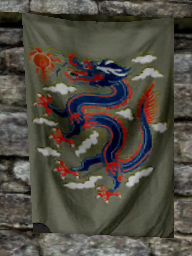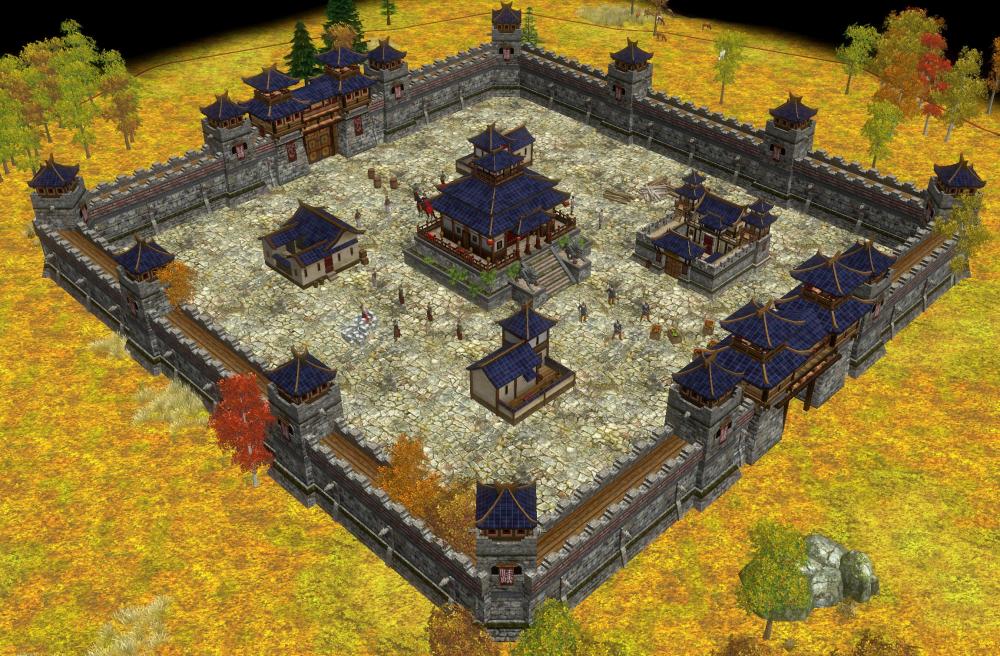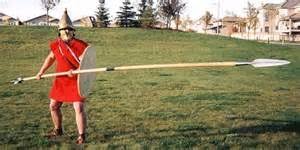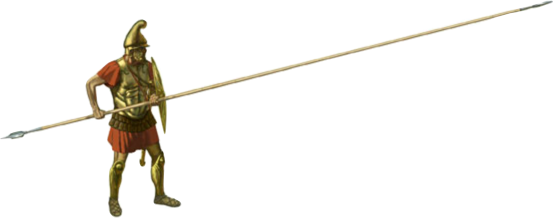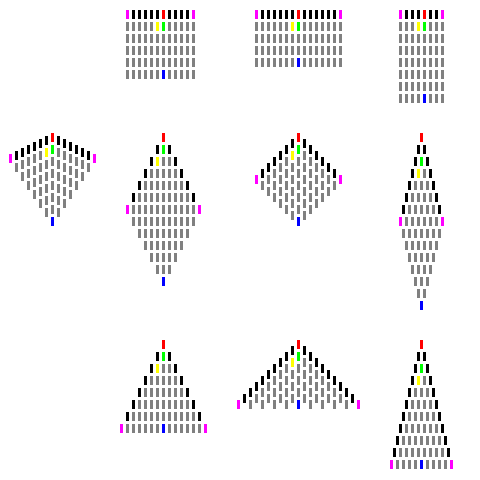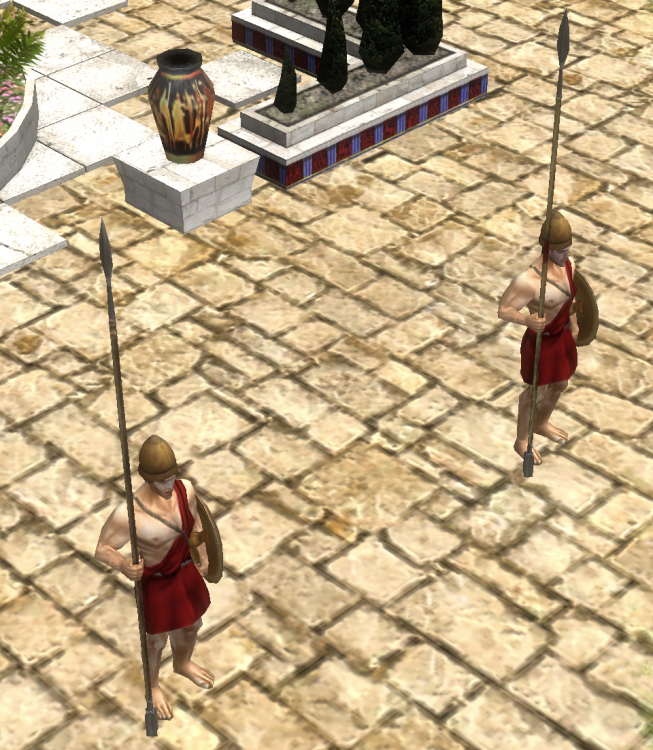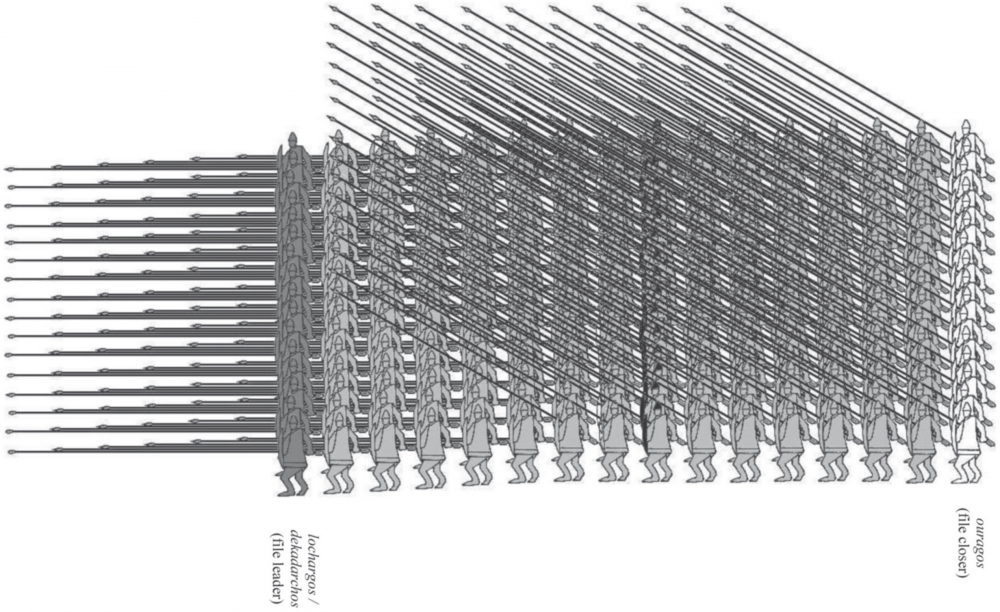-
Posts
2.300 -
Joined
-
Days Won
23
Everything posted by Nescio
-

[reference] Han dynasty Chinese architecture
Nescio replied to Nescio's topic in Tutorials, references and art help
The design of the current Han farmstead appears to be based on the models of the pigsty/toilet, i.e. a place to dump waste, not to store food. A design based on the granary or perhaps the mill would probably be more appropiate. It's clear the Han had a great variety of tall, free-standing towers. This is something where China differs from the Mediterranean. To reflect that, it would by nice if the Han could have (at least) three towers: a two-storey tower in the village phase, costing 100 wood; a three-storey tower in the town phase, costing 200 wood; a four-storey tower in the city phase, costing 300 wood. As pointed out earlier, having rammed-earth walls is a sine qua non. To give a better idea how I think they ought to look like in game, I made a crude drawing of cross-sections of 0 A.D. wall segments: From left to right (red are proposed, blue existing walls): A Chinese wall with a width at base of 20, a width at top of 12, and a height of 15; because its massive size dwarfs the walls of other civs, it's probably better to reserve this for the city phase. A Chinese wall with a width at the base of 15.333, a width at top of 8, and a height of 10; this has a similar height to the city walls of other civs, and is therefore suitable for the town phase. A Chinese wall with a width at the base of 6.667, a width at the top of 4, and a height of 5; a small version for the village phase. The current Han China wall, which has a width of 7 and a height of 10; ought to be deprecated. The current Carthaginian wall, which has a width of 7 and a height of 12, is currently the largest wall in the public mod. The current Macedonian wall, which has a width of 5 and a height of 11.5, is probably the most typical wall size. The current Roman siege wall, which has a width of 4 and a height of 5.7, is the smallest full-length wall. The widths are the <Obstruction> depths, the heights the <TurretPoints> <Y> position, i.e. the offset at which units on the walls are placed, thus without battlements, roofs, etc. (The normalized cross-section volumes are, respectively, 240, 116.7, 26.7, 70, 84, 57.5, 22.8.) -

[reference] Han dynasty Chinese architecture
Nescio replied to Nescio's topic in Tutorials, references and art help
It's unclear to me which revision you mean. Moreover, on my end I don't get errors. Could you update (svn up) 0 A.D., update (git pull) the Han China mod, disable all other mods, and try again? -
Currently there are 86 project languages listed at https://www.transifex.com/wildfire-games/0ad/ While about a dozen is nearly complete (>95%) and many are progressing nicely (e.g. Latin is at 55%), a number of languages is still at 0%. Some of those seem to be political additions: Arabic (Egypt) Arabic (Iraq) Arabic (Saudi Arabia) Chinese (Singapore) Russian (Ukraine) Now I'm aware there are dozens of varieties of Arabic; however, there appears to be only one written form of Arabic. As for Chinese, I believe there are basically two writing systems: simplified characters are used in mainland China and Singapore, traditional characters in Macau, Honk Kong, and Taiwan. And while a significant portion of the Ukrainian population speaks Russian, I don't think they write it differently than in Russia. @Gallaecio, @GunChleoc, @Itms, whoever is in charge of 0 A.D. localization on transifex, is it worth keeping these languages? I also have doubts about: French (Canada) Spanish (Argentina) Spanish (Chile) Spanich (Colombia) —requested— Spanish (Mexico) Again, what should matter is orthography (how it's written), lexicon (vocabulary), and grammar; I'm unsure how great the differences actually are. (To be clear, I'm certainly not opposed to maintaining different versions of languages; English in the USA is written differently than in the UK, and Portuguese in Brazil is not the same as in Europe and Africa; or Croatian/Serbian and Hindi/Urdu.)
-

[reference] Han dynasty Chinese architecture
Nescio replied to Nescio's topic in Tutorials, references and art help
It looks better, thank you; at least it's not as shiny as the current version. Could you make a pull request to https://github.com/0ADMods/han_china ? -

[reference] Han dynasty Chinese architecture
Nescio replied to Nescio's topic in Tutorials, references and art help
Baskets, pottery, tools, etc. are welcome. Wooden elements painted in player colour are fine too. But elements that are well known to emerge only in much later centuries shouldn't be included, such as this Qing-style dragon flag: -

[reference] Han dynasty Chinese architecture
Nescio replied to Nescio's topic in Tutorials, references and art help
Some other anachronisms in the current Han mod structures: stone: barracks, civic centre, defence tower, fortress, range, temple, gate, wall tower fancy flags: barracks, forge, fortress, range, gate, wall tower, wonder paper lanterns: civic centre, dock, fortress, government centre Chinese stone lions: civic centre, government centre bagua/eight trigrams: temple Here's one from the Western Zhou: http://hua.umf.maine.edu/China/Xian/Shaanxi_History/pages/076_History_Museum.html I've also found a Han carved stone depicting an ancestral worship hall (i.e. a temple): And the current Han wonder seems to be based on this: http://hua.umf.maine.edu/China/Xian/Shaanxi_History/pages/138_History_Museum.html Whoever made it for 0 A.D. did a great job! I don't really like the Greek-style stone steps around, nor the flower beds on the corners. Perhaps it could get a low circular platform instead, like the one linked? @Stan`? -
@wolflance, are you still around? If so, could you have another look at the current Han China mod? Its newest version is located at https://github.com/0ADMods/han_china I don't know any Chinese, so it's quite hard to verify the specific names used are correct. And please point out any other anachronisms or inaccuracies you spot!
- 3 replies
-
- Rise of the EastUnit
- China
-
(and 2 more)
Tagged with:
-

[reference] Han dynasty Chinese architecture
Nescio replied to Nescio's topic in Tutorials, references and art help
The main point is that e.g. Ming or Qing architecture is not representative for Qin or Han. As you can see a number of those have stone masonry, which is anachronistic (also for Mauryas). The rammed-earth technique was also used for creating platforms upon which buildings could be erected (e.g. temple, civic centre). Furthermore, the rooftiles are too shiny and too blue. I'd also welcome a new fortress design, more similar to this: -

[reference] Han dynasty Chinese architecture
Nescio replied to Nescio's topic in Tutorials, references and art help
And another important thing: defensive walls. The Great Wall of China is world famous. And although parts of it were built during 0 A.D.'s timeframe, the best preserved, most visited, and most photographed sections were built by the Ming, which is not quite representative for Han China: Some ruins of Han dynasty fortications are still standing at the Yumen Pass, also called the Jade Gate, the western-most point of entry of Han China, near Dunhuang in Gansu: In the Mediterranean, city walls were typically 2 to 6 m thick and 8 to 12 m tall (there are exceptions), with the outside stone masonry and the core filled with rubble, rocks, pebbles, broken bricks, mortar, etc. In the Near East sun-dried mud bricks or fired bricks were used. In ancient and classical China, defensive walls were instead made from rammed earth (hāngtǔ). The upside is you don't have to obtain suitable materials from elsewhere, but the downside is that's extremely labour-intensive. (That was also one of the reasons why the under the population was subject to corvée labour under the Han, originally one in five months, later one month per year.) Due to the nature of the technique, Chinese city walls were much, much wider than those in the Mediterranean; some examples: Panlongcheng (Shang): 26 m thick at base Zhengzhou (Shang): 22 m thick at base Sanxingdui (Shang): 40 m thick at base new palace city at Linzi (Warring States): 28 to 38 m at base Xi'an/Chang'an (Han): 12 to 16 m thick at base Xi'an/Chang'an (Ming): 15 to 18 m thick at base, 12 m tall Beijing inner city (Ming): 20 m thick at base, 12 m thick at top, 15 m tall Moreover, while city walls in the Mediterranean were more or less vertical, Chinese walls were tapered (i.e. wider at base and narrower at top). To better illustrate the shape, a photograph and a model of Ming city walls (note though that Ming walls were covered on the outside with bricks, which was not yet the case under the Han and earlier dynasties): Finally, 0 A.D.'s Han China mod walls (which clearly look nothing like the above, and thus ought to be replaced): -

[reference] Han dynasty Chinese architecture
Nescio replied to Nescio's topic in Tutorials, references and art help
The primary building material in ancient and classical China was wood; walls could be covered by clay, earth, loam, plaster, etc. These are not the most durable materials, therefore very little has survived to the present day. (A similar problem exists elsewhere in the world, e.g. Etruscans or the Roman Republic, but that discussion belongs elsewhere.) Rooftiles were used too, at least in urban areas (though I highly doubt they're all of the shiny blue glazed variety 0 A.D.'s Han China mod structures currently have). Stone appears to be mostly used for sculpture. What has survived from the Han period are hundreds of tombs near the capital, some very well-preserved, including, amongst other things, texts (yay!), paintings, and terracotta miniature models of buildings. Some examples: well: pottery: stove: kitchen: rice paddy: goat/sheep pens: pig sties/toilets: mill (and bakery?): granaries: houses: towers: fort: manor/palace: Note the bilateral symmetry (i.e. left mirrors the right). (All images are from Wikimedia Commons: https://commons.wikimedia.org/wiki/Category:Ceramics_of_the_Han_Dynasty_-_Models_of_buildings ) -
This thread is for sharing and discussing information on architecture for the Han China civilization. While I'd like to see them included in the public mod, I think it's important they're based on reliable sources, and stark anachronisms should be avoided. (I had a quick look at the ROTE subforum, but didn't see a discussion on this specifically, hence why I'm starting a new thread.) Before posting whatever turns up in a quick search, please verify it's actually from the Han dynasty, and not from some later period: c. 1600–1045 BC Shang or Yin c. 1045–771 BC Western Zhou 771–481/403 BC Spring and Autumn 481/403–221 BC Warring States 221–206 BC Qin 202 BC–AD 9 Western or Former Han AD 25–220 Eastern or Later Han ... 618–907 Tang 960–1279 Song 1271–1368 Yuan (i.e. Mongol) 1368–1644 Ming 1644–1911 Qing (i.e. Manchu) Also, unless stated otherwise, all names are in hànyǔ pīnyīn, not in Wade-Giles or some other transcription system.
-

Spidermonkey 68 & 78 upgrade
Nescio replied to wraitii's topic in Game Development & Technical Discussion
Yes, that one I have: -

Spidermonkey 68 & 78 upgrade
Nescio replied to wraitii's topic in Game Development & Technical Discussion
Congratulations! Does it? Fedora 33 with gcc 10.2.1 here; I believe I don't have llvm installed. I did a clean build and everything seems to work when I run the game. -

How can I add a new civ to 0 A.D. via modding?
Nescio replied to Lunari8546's topic in Game Modification
First of all, which version of 0 A.D. are you using, the latest stable (A23) or the svn development version (A24)? If you take files from a A24 mod and apply them on A23, or vice versa, you're very likely to encounter errors. It's best to disable all other mods and take files directly from the default (public) game. You can browse the latest stable files at https://github.com/0ad/0ad/tree/eb2fc5c53d0c55de308be6dc5bb7f952cfbc210d/binaries/data/mods/public and files of the svn development version at https://trac.wildfiregames.com/browser/ps/trunk/binaries/data/mods/public . To introduce a new civilization, you need to add a simulation/data/civs/{civ}.json file, yes. You can copy one from elsewhere and edit it, or write a new one from scratch. Open the file in a text editor. The crucial thing is the civ code (line 2), e.g. "Code": "athen", This should match the file name (hence athen.json), is used for civ-bonuses and technologies (under simulation/data/technologies), and entity templates (under simulation/templates). Now if view the rest of your {civ}.json file, you'll see many fields (e.g. "Emblem", "Music", "WallSets", "StartEntities", "Formations", SkirmishReplacements") include file names. Make sure those files actually exist, and verify they're correct! Otherwise you will get errors. You also might want to have a look at https://wildfiregames.com/forum/topic/21083-how-to-modify-0-ad/ , a thread containing a lot of questions and answers about modifying the game. -
Do you mean the “Elephant Roundup” as displayed on the Mauryan Civilizations/History page in game? Unfortunately the civilization overviews contain a lot of misinformation. There is a patch for that ( https://code.wildfiregames.com/D2720 ), but it needs to be reviewed before it can be included in the development version. Information displayed in the Structure Tree is correct.
-
Now there is: https://code.wildfiregames.com/D3172 Feel free to introduce them, art is your area.
-
For auras, a radius from centre makes sense, as does a distance to edge for e.g. wonder-size structures. However, the current distance to circle around entity is not entirely satisfying. By the way, are the attack, aura, and heal range visualizations adjusted?
-
@Crea, you're completely right, the game is quite sexist. The problem is that history is rather sexist, and 0 A.D. generally values realism and historical accuracy. That said, I'm not quite happy with 0 A.D.'s current situation either. A minor improvement in the development version is that female citizens can now initiate all structure foundations, just like (male) citizen soldiers, but yes, that's just a small step and more has to be done. Unfortunately, while identifying what's wrong is relatively easy, the difficulty is how to solve something properly. Citizens as in citizens (i.e. citizenship), or citizens as in 0 A.D. (i.e. workers)? If the former, all, if the latter, none: just male workers is probably more realistic. As for the aura, just delete it. It's not only sexist, but also unrealistic and without historical justification. Moreover, I doubt the AI understands how to make use of it. Yes, slavery existed, and yes, slavery was important. However, slavery is not the only form of labour, and not everyone owned slaves. Society was largely rural, agriculture the main form of employment, and most of it done by men working their own land, or poorer people working that of richer landowners. As for Han China, there were indeed only small numbers of slaves, and most of them household slaves working indoors, however, corvee (of ordinary people) and forced labour (of convicts, debtors, prisoners, etc.) were very important there. There are numerous examples of women having political power (often through a husband, brother, or son), and even a few of women leading armies or being present at the battlefield (e.g. Ptolemy's sister and wife Arsinoë was with him during the Battle of Raphia (Polybius V.84.1)). However, women actually fighting is something quite different. Actually it really does not. In Greek society women were kept indoors, while men worked the land. And citizenship implied political rights. Mercenaries were foreigners, not citizens, and having soldiers quarry stone or mine ore is rather unrealistic too. Anyway, in 0 A.D. female citizens have different work rates than male citizens. In my opinion male workers should be introduced with exactly the same values as their female counterparts, for all factions. In Age of Empires II, there were no differences between male and female villagers either.
-
Beta would mean the game is feature-complete and no new mechanics will be added; 0 A.D. is not at that stage, hence alpha. There is a roadmap (https://trac.wildfiregames.com/roadmap), but no date. While team members are busy or working on technical and complicated tickets (e.g. upgrading SpiderMonkey 45→52→60→68→78), it makes sense to continue improving other things, such as art or gameplay. Not every patch has to be accepted and committed, of course. However, if something seems an improvement or an idea worth trying, it's better to have it merged sooner rather than later, to give people playtesting the development version more time to figure out the combined effects of all changes and spot aspects that are poor and should be improved. If a committed patch turns out to be a change for the worse, it can always be amended or reverted.
-
Currently there is a backlog of about 50 open gameplay patches; see https://code.wildfiregames.com/search/query/4pPnEvE_Ol0A/ for a full list. Not all of them are ready to be merged; some have been ignored so far, and many need to be rebased because of commits in the months since they were last updated. Earlier today I've rebased those patches that have been accepted at some point: https://code.wildfiregames.com/D2493 (make siege engines uncapturable) https://code.wildfiregames.com/D2494 (overhaul artillery attacks) https://code.wildfiregames.com/D2507 (allow building palisades in neutral terrritory) https://code.wildfiregames.com/D2801 (enable stable for all civilizations) https://code.wildfiregames.com/D2815 (give all civs rams) https://code.wildfiregames.com/D2853 (adjust elephant template values) https://code.wildfiregames.com/D2856 (redo special_war_horses technology) https://code.wildfiregames.com/D2863 (deprecate stoas and stoa champions) https://code.wildfiregames.com/D2939 (delete armor_hero_01 technology) https://code.wildfiregames.com/D2950 (keep population for houses) https://code.wildfiregames.com/D3174 (alter rome army camp production queue) And a few others: https://code.wildfiregames.com/D2886 (introduces crossbowman templates, and also gives them different values, because currently the champion crossbowman has only one-sixth the damage per second of its archer counterpart) https://code.wildfiregames.com/D2951 (merge wonder population auras) https://code.wildfiregames.com/D2993 (add visible garrison points to rome siege wall tower) All of the above are ready to be merged. However, team members are very reluctant to commit anything that might alter gameplay balance, therefore more people are needed to have a look at these patches, and click “Request Changes” (if you think they shouldn't be committed in their current state) or “Accept Revision” (if you approve of them).
-
The saris(s)a was discussed by various ancient authors and its length is know to have varied over time. The numbers I mentioned are all attested. For more details, see Christopher Matthew “The Length of the Sarissa” Antichthon 46 (January 2012) 79–100 https://doi.org/10.1017/S0066477400000150. The justification for giving different civs different pike lengths is that, while 0 A.D. aims to cover the entire 500–1 BC timeframe, each faction is mostly focussed on a particular point in time; e.g. Macedonians on Alexander the Great, and Ptolemies on Ptolemy IV, and Romans on the Second Punic War. To be clear, I'm not saying all civs must have different weapon lengths; however, I do think it's a suggestion worth exploring, and mods are great for that.
-
Out of curiosity, is having say three knives used by all civs worse than each civ one knife only they use?
-
Yes, currently they arch their backs a bit (like a “C”), which I imagine is quite tiresome. The men should stand upright (like an “I“): Indeed, structures are not to scale, nor should they be; maps in 0 A.D. are much too small for that. I doubt even a giant map would reach a kilometre across. On the other hand, rabbits are disproportionally large, which is fine, they're already difficult enough to see when zoomed out. So no, I'm certainly not arguing everything should be of one and the same scale. However, the differents parts of an entity ought to be about proportional; capes and shields are on the same scale as the men, for good reason; in my opinion pikes out to be relative to that too. In reality pikes were about two to three times as long as thrusting spears, or four to six times the length of javelins. Part of 0 A.D. is educational, and having more accurate pike lengths won't hurt. It's in small details the game can really shine. Indeed! Or differentiate factions; e.g. Iphicrates' peltasts a 10-cubit pike, Alexander's phalangites 12-cubit pike, Seleucid's a 16-cubit pike, Ptolemies a 14-cubit pike. Moreover, having properly long pikes would allow mods to experiment with the syntagma.
-
Aelian Tactica §18–19, Arrain Tactica §16–17, and Asclepiodotus Tactica §7 describe cavalry formation in detail. After rereading those a few times, I made a drawing of the various formations actually used by ancient cavalry: Colour scheme: red is the squadron leader, blue the rear commander; magenta the flank guards; green the leader of the second line; yellow the standard-bearer; black the front line; grey the other horsemen. From left to right: first row: square formations, used by Persians, Greeks, and Sicilians. They're simplest to form and hold together, but also the most rigid and hardest to turn around. square with twice as many horsemen in a row as in a column; because horses are longer then they're wide, this one best approaches a square square with three times as many horsemen in a row as in a column; this one is thus a bit wider, and useful if you want to outflank the enemy, fear being outflanked, or want to suggest you have more cavalry you actually have square with the same number of horsemen, thus significantly deeper than it's wide; as such it's useful for hiding your numbers, misleading your opponents, making them believe your cavalry force is much smaller than in reality second row: rhombus formations, pioneered by the Thessalians (northern Greece); it's very flexible, and great for defending against incoming attacks, regardless the direction they come from. a rhombus with neither rows nor columns a rhombus with both rows and columns a rhombus with only columns, not rows a rhombus with only rows, not columns third row: wedge formations, favoured by Scythians, Thracians, and Macedonians. Great for fast charges. a wedge with both rows and columns a wedge with only columns, not rows a wedge with only rows, not columns The wedge formation in 0 A.D. is number ten; by removing the <ShiftRows> line you get number eight. Numbers one, two, three can be easily produced by setting <FormationShape> to square and <WidthDepthRatio> to 2, 3, and 1, respectively. However, I have no idea how to produce number nine, nor any of the rhombus formations. I suppose it could be achieved by editing simulation/components/Formation.js, though I don't know how. I could really use someone to help me out.
- 1 reply
-
- 1
-

-
Although in 0 A.D. pikes are visibly longer than spears, they're represented shorter than the were in reality. When zooming in, it seems 0 A.D.'s pikes are about twice as long as the men: Let's say a man is 1.8 m tall, then these pikes are 3.6 m. We know from Hellenistic authors pike length varied over time (I posted a summary in this post), but even the shortest (4.8 m) were a third longer than 0 A.D.'s, and the longest (7.68 m) over twice as long. I vaguely recall humans being about 4 Blender units tall (@Stan`?), so I guess the current pikes are 8 Blender units. It would be great if someone could create longer pikes, preferably four sizes: 10, 12, 14, 16 Blender units. Or, to put it differently, 25%, 50%, 75%, and 100% longer than the current version. And another thing. When playing around a bit with the syntagma formation, the pikemen in the front rows seem to physically bend (@Alexandermb); this is wrong: in reality the men should stand upright, holding their pikes horizontal. Lowering your back means you occupy more space, and the idea of the syntagma (‘square’: 16×16) is its closed-packedness. Furthermore, actually the first five or six rows held their pikes horizontal, the men in the rows behind them at angles of c. 45°:



